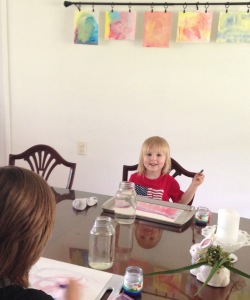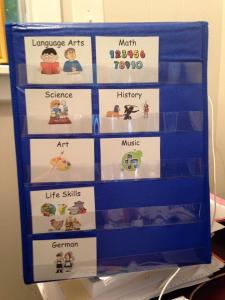 If you’ve done any reading at all about Waldorf education, you have surely encountered Waldorf’s three R’s: rhythm, rhythm and rhythm. Yes, rhythm is a BIG DEAL in Waldorf world! Visit any Waldorf-inspired blog and you will likely find a post. Google “Waldorf rhythm” and you get 461K results! Pinterest is full of Waldorf rhythm pins and every Waldorf book will include it. In fact, there are actually entire Waldorf books just about rhythm – why you need one, what it is, how to tweak it, what to put in it, how to get your family doing it, etc. Every website I’ve visited, every book I’ve read, when they get to the practical steps to establishing a Waldorf home starts with rhythm. There’s just no escaping it, no skipping it, no racing on to the gnomes, play silks and knitting. Even if you do race on to the gnomes, play silks and knitting…you will eventually find yourself back where you started trying to figure out rhythm!
If you’ve done any reading at all about Waldorf education, you have surely encountered Waldorf’s three R’s: rhythm, rhythm and rhythm. Yes, rhythm is a BIG DEAL in Waldorf world! Visit any Waldorf-inspired blog and you will likely find a post. Google “Waldorf rhythm” and you get 461K results! Pinterest is full of Waldorf rhythm pins and every Waldorf book will include it. In fact, there are actually entire Waldorf books just about rhythm – why you need one, what it is, how to tweak it, what to put in it, how to get your family doing it, etc. Every website I’ve visited, every book I’ve read, when they get to the practical steps to establishing a Waldorf home starts with rhythm. There’s just no escaping it, no skipping it, no racing on to the gnomes, play silks and knitting. Even if you do race on to the gnomes, play silks and knitting…you will eventually find yourself back where you started trying to figure out rhythm!
If you haven’t done any reading at all about Waldorf education, check out the links on this post. For rhythm-specific reading, my favorites can be found here on Waldorf Essentials by Melisa Nielsen and this post at Waldorf Inspired Learning. These ladies do an amazing job of explaining what you need to know about rhythm – what it is, why you need it, how to do it, etc.
Fortunately for me, we already had a good start on rhythm before coming to Waldorf. I don’t consider myself to be especially organized, but I am a rather regularish sort of person – a regularish sort of person with two small children I homeschool, a household to run and a menagerie to tend. Out of necessity, I have had routines in place for a long time! But as I dove into my rhythm reading, I realized that what I was doing was not a rhythm. A rhythm is not simply “Breakfast at 7, Lunch at 12, Rest at 1” or “clear the table, put away leftovers, wash the dishes” or even “floors on Monday, bathrooms on Tuesday, kitchen on Wednesday” – a rhythm is so much more!
Rhythm is a pattern of in breaths and out breaths.
??????????
Yeah. That breath thing made no sense to me. So, I read some more and then put it into terms that mean something to me – music terms!
What does rhythm mean in music? Well, as a Kodaly-inspired educator, this means the children first learn to “pat steady” to a bank of folk songs. Once they can do this, then I give them the term “steady beat” to name that constant patting, stomping, clapping, dancing heartbeat they have experienced. Then I guide them to identify that the words of the songs don’t plod along following that steady beat exactly, one word to a beat. Some words do fall exactly on the beat – but some crowd together and move faster than the beat. And sometimes there are no words at all – just a beat or more of total silence. Once the children have found places in their familiar songs that do all of these things, I give them the term “rhythm” to name the concept of patterns of short and long sounds and silences. Next come the names for those sounds and silences – quarter note, eighth note pair and so on.
As their musical repertoire grows and they create their own songs, we explore how different rhythmic patterns evoke different moods and sensations and this is where Waldorf rhythm starts to make sense to me! They experience the excitement – and exhaustion! – of many rapidly repeated notes, of accelerando (speeding up). They feel soothed by a succession of slow, sustained notes and ritardando (slowing down). They feel anticipation or completion at a rest and the engagement that happens when rhythms vary, the lack of satisfaction when changes are too abrupt.
Here is the song we were singing before I thought about home rhythm in these terms.
Daily Rhythm
6:00 Good Morning!
6:30 Breakfast, clear table; dress, teeth, hair.
7:30 Outside Play/Mom does chores
8:30 Monday – Friday: Main Lesson; Saturday – Sunday: Free play.
9:30 Snack Time
Monday – Friday: Lively Arts
Saturday: Library/Baseball
Sunday: Free Play
12:00 Lunch, clear table
Free Play
1:00 Rest Period
3:00 Walk Dog
Free Play/Housework and Dinner Prep
5:30 Evening Activities
6:30 Dinner
7:30 Shower, Pajamas, Teeth, Etc. Maybe a story if we aren’t furious with each other.
8:00 Good Night!…maybe. Probably not. Up and down, and round and round.
You can see there was a lot of free play while I tried to get things done – free play that usually became a free-for-all. Someone almost always got hurt, something almost always got destroyed – and I wasn’t really getting any of those things done I was trying to do! And meals and rest times were battlegrounds!
My study of Waldorf rhythm has brought me to compose something new – a day with rhythmic variety without any abrupt changes. I’ve tried to alternate “rapid notes” and “slow notes” and I make sure we have some strategic “rests” as well. I’ve also thought about transitions and incorporated accelerandi and ritardandi to eliminating abrupt shifts.

Of course, I am also learning that no matter where we are in our rhythm, my active engagement is required. We can alternate degrees of my active engagement – I can teach a lesson, then work on computer, read them a story, then fold laundry while they play – but I can’t check out for long stretches of the day to play on Facebook clean. I can have tiny little breaks – a quarter rest, maybe even a half rest – but no tacit for mommy! (A tacit is when a musician has rests for a really long time, pages even.)
Armed with a new understanding of rhythm, our days now look like this:
Daily Rhythm
6:00 Good Morning!
6:30 Breakfast, clear table, dress, teeth and hair
Morning Home Care (Daily chores we do together)
Outside Play & Nature Walk
8:30 Monday – Friday: Main Lesson
Saturday – Sunday: Free Play/Special Time
9:30 Snack Time
Monday – Friday: Lively Arts
Saturday: Library/Baseball
Sunday: Free Play
12:00 Lunch, clear table
Story Time
1:00 Rest Period
3:00 Walk Dog
Afternoon Home Care (Major chores we do once a week, together)
Handwork
Meal Preparation (which we often do together)
Free Play
5:30 Evening Activities
6:30 Dinner
7:30 Shower, Pajamas, Teeth, Etc.
Story
8:00 Good Night!
You can see that our morning time still begins with a lot of focused activity – eating, getting dressed, morning chores. I have accepted that I am going to have be actively involved many times – they aren’t going to dress, etc., without my being present in their room. This sustained concentrated effort is hard for Scooter and Cheech (and me…) but once done, they get to slow down and play outside and I finish up my morning routine. After a short time on their own, I take them on a nature walk. This time acts as a gradual accelerando into main lesson time and has been smooth sailing since the change! (Gnomes be praised!) Lively Arts act as a lovely little ritardando right through lunch and story culminating in a satisfying and welcome rest. After rest, we jump right into activity/accelerando – walking the dog and hard-core housework (together!). Handwork, which is somewhat active (mentally) but also relaxing (physically) creates a great ritardando into dinner prep time and free play. Our evening activities are usually another series of “rapid notes” before our final ritardando – dinner, getting ready for bed and a story. By the time we get to bedtime, that rest is (mostly) welcome. Some days circumstances (illness, baseball practice, torrential rains) intervene and we have to rearrange – we play jazz and improvise. But having once established the rhythm, we can easily reestablish it after any departure.
Of course, rhythm is only one part of those changes, but it is a BIG part! My kids are getting regular doses of intense mental/physical activity and interaction with me and each other throughout the day as well as and regular doses of less intense activity and interaction. Overall, they are calmer, more cooperative and we are more connected. And that is good for all families, right? Not just homeschool families or Waldorf families!












